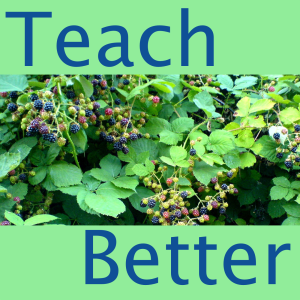
Professor Lynne Regan from Yale’s Department of Molecular Biophysics and Biochemistry believes in the power of active learning. In this episode she shares what she’s learned incorporating active learning exercises into her classes.
You can subscribe to the Teach Better Podcast through your favorite podcast app or simply subscribe through iTunes if you don’t have one yet.
Show Notes0:00 ⏯ Intro
0:42 ⏯ Sometimes the President of the Protein Society gets asked awkward questions. Working between disciplines.
2:08 ⏯ Teaching a wide range of methods to students with a wide range of backgrounds.
5:44 ⏯ Students answering questions vs. forming questions.
7:20 ⏯ What Lynn’s classes were like when she arrived at Yale 25 years ago.
8:32 ⏯ Trying different things–like bringing actual data into the problem sets.
10:00 ⏯ Bringing Oxford and MIT methods to Yale.
12:42 ⏯ A department re-organizes around half-semester modules.
13:56 ⏯ A typical meeting with breakout sessions. Adjusting group size and question ‘size.’
16:00 ⏯ A first question about scale and size. How do 50,000 ribosomes fit in a cell? Is this a small collie or a large rabbit?
19:00 ⏯ Group work with each group doing different problems multiplies the opportunities for students to learn. Can one person plant one million trees in a lifetime?
22:27 ⏯ 15 minutes for one breakout group activity.
23:22 ⏯ “Vendors and Clients.” Evaluating different biophysical measurement methods.
27:22 ⏯ Making the student an agent in a novel, authentic and role-based scenario with persuasion.
28:53 ⏯ Lynn-ifying your group exercise. Avoiding making the group problems too easy. Dealing with different skill levels in group work.
32:14 ⏯ Why use different questions for each group? Assembling the groups by choice and randomly. Not switching them around too much.
36:00 ⏯ Why do teachers start to change the way they teach? The intuitions teachers use to make decisions. Reading about teaching and making administrative and organizational choices.
38:14 ⏯ Taking inspiration from the students: helping students learn about networks through food and movie choices.
40:32 ⏯ Making concepts tangible and surprising to students.
41:40 ⏯ Teaching content vs. teaching how to choose a problem-solving methods. The GIGO principle. Different instruments and methods give different pictures of reality.
45:38 ⏯ How do you know the students are learning more?
48:59 ⏯ Biggest teaching ‘mistake’? Interacting with students and wrestling with difficult material is inspiring. The timing of the breakout sessions is tricky.
52:23 ⏯ Teaching about skills rather than topics. Skills also carry concepts and choices with them.
53:24 ⏯ Active learning isn’t just for undergrads, and it’s not just about keeping students awake.
54:47 ⏯ How using Google in the classroom sometimes leads to Monty Python.
56:48 ⏯ Thanks and sign-off.
More Episodes
Create your
podcast in
minutes
- Full-featured podcast site
- Unlimited storage and bandwidth
- Comprehensive podcast stats
- Distribute to Apple Podcasts, Spotify, and more
- Make money with your podcast
It is Free
- Privacy Policy
- Cookie Policy
- Terms of Use
- Consent Preferences
- Copyright © 2015-2024 Podbean.com






